Introduction
Curing is the process of providing moisture to the concrete mix so that better interlocking is established. If curing is not done properly then it will cause insufficient hydration and as a result there will be capillary pores, causing cracks and shrinkage. Moreover, strength and durability will also get affected and the concrete will disintegrate and break. It also ensures to maintain a sufficient temperature of concrete at its early age. It must be implemented as soon as placement & finishing is done. Also, it must continue for a specific period for the concrete to achieve its desired strength and durability. Uniform temperature is necessary to avoid thermal shrinkage cracks, plastic shrinkage and problems like bleeding and segregation.
Why curing is done?
Some of the reasons of curing of concrete are –
- To achieve a densely populated microstructure and have sufficient impermeability, long period curing is a must which leads to increase in durability. It helps to develop calcium silicate hydrate gel, which acts as a binder between aggregates to form a rock-solid mass, and enhances the physical and mechanical properties of concrete.
- It makes the concrete impermeable that prevents water-borne chemicals from getting mixed with the concrete, thereby increasing serviceability.
- Concrete when cured properly has improved surface hardness and can better withstand wear-and-tear and abrasion.
- It helps to prevent dusting, segregation, grazing and scaling.
- It reduces shrinkage and improves long-term appearance.
Types of Curing
There are three methods of curing –
1. Method 1 – Methods that preserve mixing water in the concrete during the early hardening period. These include spraying and fogging, ponding or immersion, and saturated wet coverings. These methods facilitate cooling of concrete through evaporation that is beneficial in hot weather.
2. Method 2 – Methods that prevent the loss of water from the surface of the concrete. This can be implemented by applying plastic sheets or impervious sheets or by application of membrane forming compound.
3. Method 3 – Methods that increase the rate of gain of strength by addition of heat and moisture to the concrete. It is implemented with the help of live steam, heating coils or electrically heated pads.
Method 1
- Ponding or Immersion – It is applied on flat surfaces such as pavement, floors, etc. It is a method in which earth or sand dikes are placed around the perimeter of the concrete and then water is poured in it. It is a best method for preventing loss of moisture and also it helps in maintaining a uniform temperature. The water sued for curing should not be more than 110 C to prevent thermal stresses that may lead to cracking in concrete. As it requires more labours more supervision, it is useful for small jobs.
- Fogging and sprinkling – It is an marvellous method of curing and is effective when the encompassing temperature is above the freezing and the humidity is low. A fine fog mist is applied through a system of nozzles to increase the relative humidity of air that will slow down the evaporation process. It is applied to minimise plastic shrinkage cracking. When the concrete sets, ordinary lawn sprinklers are effective for curing if there does not arise any issue for water run-off. When the applied surfaces are vertical then it is beneficial to use soaker hoses.
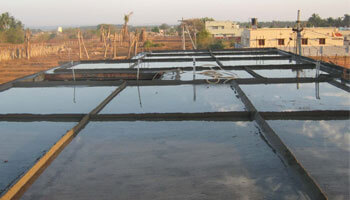
Fig 1: Immersion of concrete
Courtesy: Builders Mart
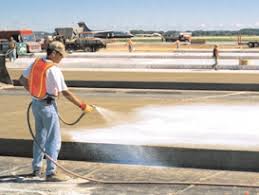
Fig 2: Sprinkling on concrete
Courtesy: Ce.Memphis.Edu
Method 2
- Wet Coverings – Clothes when saturated with water such as burlap, gunny bags, cotton mat rugs, and many more, can prove to be effective for curing. These reflect light and are resistant to fire as well. However, the cloth must be free from any kind of impurities or else it will cause discolouration in concrete. New cloth must be thoroughly rinsed with water to remove any soluble impurities and to increase the absorbing capacity of the cloth.
- Impervious Paper – It consists of two sheets of Kraft paper that are cemented together by a bituminous adhesive with fibre reinforcement. These papers conform to ASTM C 171 (AASHTO M 171) and is effective to cure horizontal surfaces. One of the advantage of this method is that periodic application of water is not required. It enhances the hydration process by preventing moisture from the concrete.
- Plastic Sheets – Such sheets materials like polyethylene film can be used for curing of concrete. It is a lightweight material and effective moisture retarder that is very easy to apply on complex shapes as well.
- Membrane forming curing compounds – Liquid membrane forming curing compounds comprises of wax, resins, chlorinated rubber, etc. to prevent evaporation of moisture from concrete. It is widely used for fresh concrete. The curing compounds must maintain the relative humidity above 80% for seven days to preserve hydration.
- Internal Moist Curing – It refers to the application of moisture from within the concrete instead of providing externally. This water does not affect the water cement ratio of the fresh concrete. For this, lightweight fine aggregate or absorbent polymer should be used as they make concrete prone to self-desiccation. When more hydration is needed for concrete with low water-cement ratios, then 60 kg/m3 to 180 kg/m3 of such aggregates must be provided additionally. All the fine aggregates are replaced with these lightweight aggregates to maximize internal moist curing. Internal moist curing must be accompanied by external curing methods to increase durability and strength.
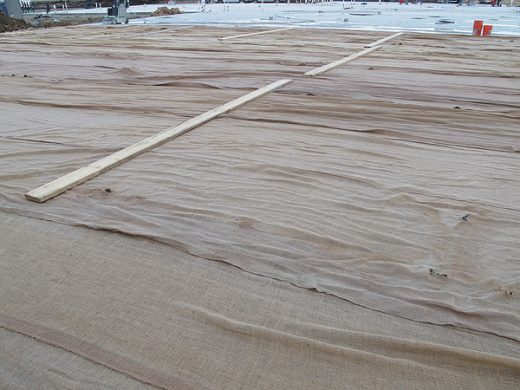
Fig 3: Wet coverings on concrete
Courtesy: Concrete Décor Magazine
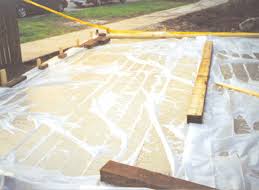
Fig 4: Impervious paper on concrete
Courtesy: Ce.Memphis.Edu
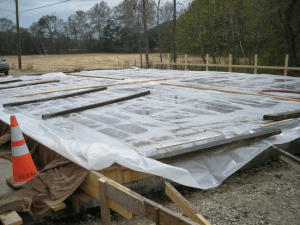
Fig 5: Plastic sheets on concrete
Courtesy: Epic projects and consulting
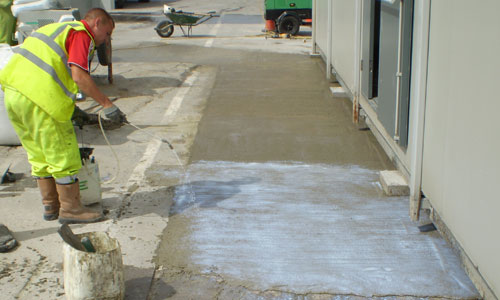
Fig 6: Curing membrane water based WB compound
Courtesy: Flexcrete
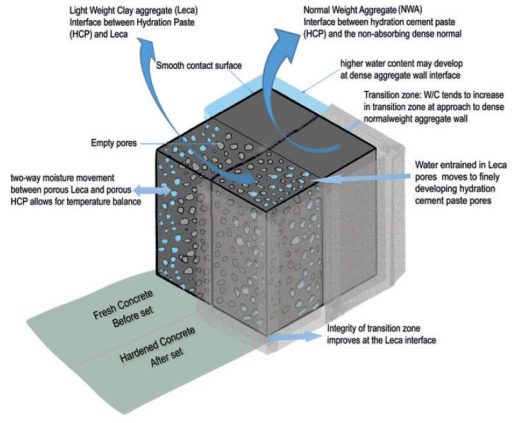
Fig 7: Internally moist curing of concrete
Courtesy: Leca AE
Method 3
- Steam Curing – It is advantageous when early gain of strength is given importance over ultimate strength.Here, additional heat is added to accomplish hydration process as in case of cold weather conditions. Two methods that fall under this category are – live steam at atmospheric pressure that is applicable for enclosed cast-in-place structures and large precast concrete units; high-pressure steam in autoclaves that is applicable for small manufactured units. A typical steam curing cycle comprises of an initial delay before steaming, a period for increasing the temperature, for maintaining the maximum temperature and a period for decreasing the temperature.
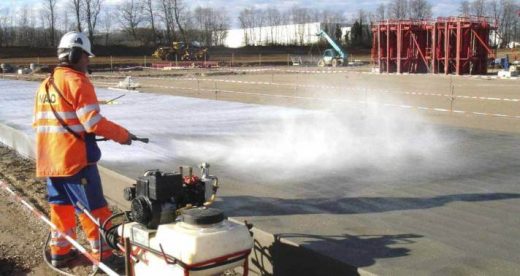
Fig 8: Steam curing
Courtesy: Sika Concrete
Conclusion
Curing methods depend on number of factors like type of materials used, size and shape of structural members, mix proportions, strength, weather conditions and future exposure conditions. The curing period varies differently like in may take 3 weeks for lean concrete to be sued in mass concrete structures such as dams or it may take few days for rich mixes. These are normally shorter for steam curing and ranges from few hours to 3 days. However, longer curing periods are desirable. For slabs, beams, columns or small footings, the curing period should be of minimum 7 days above the temperature of 50 C. When the temperature equal to or below 50 C, then the recommendations by ACI Committee 306 must below to prevent the concrete from damaging by freezing. Also, continuous supervision is required at the site to ensure that proper curing is taking place and the hydration process is continuing.
References
1. Maha Cement, “The Importance of Curing Concrete”- https://www.mahacement.com/the-importance-of-curing-concrete/
2. NBM & CW, “Significance of Curing of Concrete for Durability of Structures”- https://www.nbmcw.com/tech-articles/concrete/25057-significance-of-curing-of-concrete-for-durability-of-structures.html
3. PCA, “The Difference Between Curing and Drying Concrete”- https://www.cement.org/learn/concrete-technology/concrete-construction/drying-concrete-vs-curing-concrete
If you have a query, you can ask a question here.


